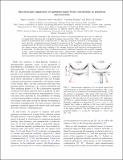Files in this item
Spectroscopic signatures of quantum many-body correlations in polariton microcavities
Item metadata
| dc.contributor.author | Levinsen, Jesper | |
| dc.contributor.author | Marchetti, Francesca Maria | |
| dc.contributor.author | Keeling, Jonathan | |
| dc.contributor.author | Parish, Meera M. | |
| dc.date.accessioned | 2019-11-08T10:30:12Z | |
| dc.date.available | 2019-11-08T10:30:12Z | |
| dc.date.issued | 2019-12-27 | |
| dc.identifier | 262911113 | |
| dc.identifier | e694c131-8328-46cb-80f3-5d7907b61f6f | |
| dc.identifier | 85077329293 | |
| dc.identifier | 000504647800007 | |
| dc.identifier.citation | Levinsen , J , Marchetti , F M , Keeling , J & Parish , M M 2019 , ' Spectroscopic signatures of quantum many-body correlations in polariton microcavities ' , Physical Review Letters , vol. 123 , no. 26 , 266401 . https://doi.org/10.1103/PhysRevLett.123.266401 | en |
| dc.identifier.issn | 0031-9007 | |
| dc.identifier.other | ArXiv: http://arxiv.org/abs/1806.10835v1 | |
| dc.identifier.other | ORCID: /0000-0002-4283-552X/work/66591895 | |
| dc.identifier.uri | https://hdl.handle.net/10023/18885 | |
| dc.description | Funding: UK EPSRC program “Hybrid Polaritonics” (EP/M025330/1) (JK). | en |
| dc.description.abstract | We theoretically investigate the many-body states of exciton-polaritons that can be observed by pump-probe spectroscopy in high-Q inorganic microcavities. Here, a weak-probe “spin-down” polariton is introduced into a coherent state of “spin-up” polaritons created by a strong pump. We show that the spin down impurities become dressed by excitations of the spin up medium, and form new polaronic quasiparticles that feature two-point and three-point many-body quantum correlations, which, in the low density regime, arise from coupling to the vacuum biexciton and triexciton states respectively. In particular, we find that these correlations generate additional branches and avoided crossings in the spin down optical transmission spectrum that have a characteristic dependence on the spin up -polariton density. Our results thus demonstrate a way to directly observe correlated many-body states in an exciton-polariton system that go beyond classical mean-field theories. | |
| dc.format.extent | 1607698 | |
| dc.language.iso | eng | |
| dc.relation.ispartof | Physical Review Letters | en |
| dc.subject | QC Physics | en |
| dc.subject | TK Electrical engineering. Electronics Nuclear engineering | en |
| dc.subject | DAS | en |
| dc.subject.lcc | QC | en |
| dc.subject.lcc | TK | en |
| dc.title | Spectroscopic signatures of quantum many-body correlations in polariton microcavities | en |
| dc.type | Journal article | en |
| dc.contributor.sponsor | EPSRC | en |
| dc.contributor.institution | University of St Andrews. School of Physics and Astronomy | en |
| dc.contributor.institution | University of St Andrews. Condensed Matter Physics | en |
| dc.identifier.doi | 10.1103/PhysRevLett.123.266401 | |
| dc.description.status | Peer reviewed | en |
| dc.identifier.grantnumber | EP/M025330/1 | en |
This item appears in the following Collection(s)
Items in the St Andrews Research Repository are protected by copyright, with all rights reserved, unless otherwise indicated.

